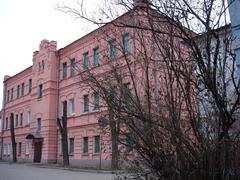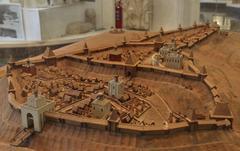Cathedral of Saint Demetrius, Vladimir, Russia: Comprehensive Guide to Visiting Hours, Tickets, and Historical Highlights
Date: 14/06/2025
Introduction
The Cathedral of Saint Demetrius in Vladimir, Russia, is a masterwork of medieval architecture and an enduring symbol of the Vladimir-Suzdal principality’s golden age. Constructed between 1194 and 1197 under Grand Prince Vsevolod III “the Big Nest,” this cathedral exemplifies the blend of religious devotion, dynastic ambition, and artistic innovation that characterized Kievan Rus’ at its height. Today, as a UNESCO World Heritage Site, the cathedral stands as a testament to the spiritual and artistic legacy of pre-Mongol Russia, drawing visitors from around the world to experience its intricate stone reliefs and storied history (Rusmania; SpottingHistory).
This guide provides a detailed account of the cathedral’s historical significance, architectural innovations, artistic features, and practical visitor information, ensuring a rewarding experience for history enthusiasts, architectural admirers, and cultural travelers alike.
Table of Contents
- Historical Background and Patronage
- Architectural Design and Stone Carvings
- Artistic Features: Facade Reliefs and Interior Frescoes
- Political and Religious Significance
- Restoration and UNESCO Recognition
- Visitor Information: Hours, Tickets, Accessibility
- Travel Tips, Nearby Attractions, and Itineraries
- Visual Highlights
- Frequently Asked Questions (FAQ)
- Summary and Recommendations
- References and Further Reading
Historical Background and Patronage
Commissioned by Grand Prince Vsevolod III Yuryevich, the Cathedral of Saint Demetrius was intended as his court chapel and a public demonstration of princely power. The dedication to Saint Demetrius of Thessaloniki—a venerated Christian martyr and military saint—was both personal (as Vsevolod’s Christian name was Dmitry) and politically astute, linking Vladimir’s rulers to the broader Byzantine Orthodox tradition (Rusmania; SpottingHistory).
The cathedral was integrated into the prince’s palace complex, symbolizing the unity of secular and religious authority in the Vladimir-Suzdal principality. This arrangement reflected the era’s intertwined relationship between the state and the Orthodox Church.
Architectural Design and Stone Carvings
The cathedral’s design epitomizes the Vladimir-Suzdal school of architecture, distinguished by its white limestone construction, cubic form, and single helmet-shaped dome. The structure is relatively compact—approximately 25 meters in height—and features three naves divided by four robust pillars (UNESCO; rbth.com).
What truly sets the cathedral apart is its exterior decoration: over 600 high-relief carvings adorn the facades, depicting biblical narratives, saints, animals, mythical creatures, and royal figures. The white stone not only imparts luminosity but also serves as an ideal canvas for this intricate sculptural program (SpottingHistory; rbth.com).
Notable Facade Features
- West facade: King David enthroned, surrounded by animals and birds, symbolizing divinely sanctioned kingship.
- South facade: Alexander the Great flanked by griffins.
- North facade: Prince Vsevolod III depicted with his sons, emphasizing dynastic continuity.
- All facades: Ornamental motifs such as lions, centaurs, eagles, and floral patterns, reflecting a blend of Byzantine, Romanesque, and Caucasian influences (mappingeasterneurope.princeton.edu; visitrussia.com).
Artistic Features: Facade Reliefs and Interior Frescoes
The cathedral is renowned for its sculptural decoration, which is unique in Russian ecclesiastical architecture for both its iconographic richness and technical mastery. The reliefs unite religious themes with symbols of princely authority and cosmopolitan artistic influences (rbth.com).
Inside, the cathedral’s decoration is more restrained but equally significant. Though many original frescoes were lost over centuries of upheaval, fragments remain—most notably of a Last Judgement scene in the apse—offering insight into the spiritual and artistic life of the 12th century (visitrussia.com).
Political and Religious Significance
The Cathedral of Saint Demetrius was built during a period of political consolidation, when Vladimir was emerging as a major center of Rus’. Its construction was both a statement of princely legitimacy and a reflection of the era’s religious fervor. By dedicating the cathedral to a warrior saint, Vsevolod III reinforced his dynasty’s image as divinely protected rulers, while the architectural grandeur projected the principality’s wealth and sophistication (UNESCO).
Restoration and UNESCO Recognition
Restoration work in the 19th century, ordered by Tsar Nicholas I, removed later additions to restore the cathedral’s “original form.” While some original reliefs were lost or replaced, much of the medieval sculpture survives. Ongoing conservation efforts focus on protecting the white-stone facades from pollution and ensuring the long-term preservation of remaining frescoes (rbth.com; UNESCO).
In 1992, the cathedral was inscribed as part of the “White Monuments of Vladimir and Suzdal” UNESCO World Heritage Site, recognizing its outstanding universal value.
Visitor Information: Hours, Tickets, Accessibility
- Location: 1 Bolshaya Moskovskaya St., central Vladimir; adjacent to the Assumption Cathedral and Golden Gate.
- Visiting Hours: Typically open daily except Mondays, from 10:00 to 18:00 (last admission at 17:30). Hours may vary seasonally or for special events—check the Vladimir-Suzdal Museum-Reserve website for current information.
- Tickets: Entry fees range from 200–350 RUB for adults, with discounts for students, seniors, and children. Tickets are available at the entrance or online (Vladimir-Suzdal Museum-Reserve).
- Guided Tours: Available in Russian and English for an additional fee. Audio guides are also offered.
- Accessibility: The site is partially accessible, with ground-level entry and ramps at main entrances, but uneven flooring may pose challenges in some areas.
- Photography: Non-flash photography is permitted inside and outside. Use of tripods or professional equipment requires special permission.
- Amenities: Restrooms, benches, shaded areas, and a small gift shop selling guidebooks and local crafts are available on site.
Travel Tips, Nearby Attractions, and Itineraries
- Getting There: The cathedral is a 10–15 minute walk from Vladimir railway station; city buses and taxis are readily available.
- Best Times to Visit: Late spring (May–June) and early autumn (September–October) are ideal for mild weather and fewer crowds.
- Dress Code: Modest attire is recommended, especially during religious services. Women may wish to bring a headscarf.
- Dining: Nearby cafes and restaurants offer Russian and international cuisine (TripAdvisor).
- Accommodation: Hotels and guesthouses are within walking distance, including Hotel Vladimir and Guest House Na Bolshoy Moskovskoy.
Nearby Attractions
- Assumption Cathedral: Renowned for Andrei Rublev’s frescoes (UNESCO).
- Golden Gate: Iconic 12th-century city gate.
- Patriarchal Gardens: Landscaped spaces with views over the Klyazma River.
A combined visit with these sites offers a comprehensive experience of Vladimir’s medieval heritage.
Visual Highlights
Intricate white-stone carvings adorn the cathedral’s exterior, a hallmark of Vladimir-Suzdal architecture.
Remnants of 12th-century frescoes, including the Last Judgement, are visible inside the apse.
Frequently Asked Questions (FAQ)
Q: What are the Cathedral of Saint Demetrius visiting hours?
A: Usually 10:00–18:00 daily except Mondays; last admission at 17:30. Hours may vary seasonally or for special events.
Q: How much are tickets?
A: Adult tickets range from 200–350 RUB, with discounts for students, seniors, and children. Purchase at the entrance or online.
Q: Is the cathedral accessible for people with disabilities?
A: The cathedral offers partial accessibility, with ramps at main entrances. Some areas inside may be challenging due to uneven historic flooring.
Q: Are guided tours available?
A: Yes, in Russian and English, for an additional fee. Audio guides are also provided.
Q: Can I take photos inside?
A: Non-flash photography is permitted; tripods or professional equipment require special permission.
Q: What else should I visit nearby?
A: The Assumption Cathedral, Golden Gate, and Patriarchal Gardens are all within walking distance.
Summary and Recommendations
A visit to the Cathedral of Saint Demetrius is an opportunity to encounter the spiritual and artistic achievements of medieval Russia in an intimate, well-preserved setting. The cathedral’s white limestone facades, dense with sculpted reliefs, tell stories of faith, power, and cultural exchange, while the tranquil interior invites contemplation of centuries-old frescoes. For the fullest experience, plan your visit in advance, consult current hours and ticketing information, and consider joining a guided tour.
Combine your visit with other key Vladimir historical sites for a comprehensive exploration of the region’s UNESCO-listed heritage. For up-to-date travel advice and personalized itineraries, download the Audiala app and explore our related resources.
References and Further Reading
- Rusmania: Cathedral of Saint Demetrius in Vladimir
- SpottingHistory: Cathedral of Saint Demetrius
- UNESCO World Heritage Centre: White Monuments of Vladimir and Suzdal
- Russia Beyond: Poetry in Stone – The Cathedral of St Dmitry in Vladimir
- Vladimir-Suzdal Museum-Reserve Official Website
- Russia Trek: Visiting the Cathedral of Saint Demetrius in Vladimir
- Mapping Eastern Europe: The Cathedral of St. Demetrios, Vladimir
- Visit Russia: St. Demetrius Cathedral
- TripAdvisor: Vladimir Restaurants


